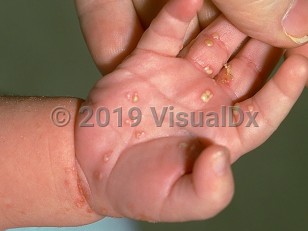Congenital candidiasis
Alerts and Notices
Important News & Links
Synopsis

Congenital cutaneous candidiasis (CCC) is an uncommon and potentially serious condition resulting from infection with Candida spp. acquired in utero. Approximately 100 cases have been reported. Infants present within the first 6 days of life with a broad range of cutaneous findings ranging from a few erythematous papules to a diffuse desquamating erosive dermatitis. Neonatal candidiasis, by contrast, is acquired by passage through an infected birth canal. These patients present after the first week of life with diaper dermatitis or thrush.
The etiology is thought to be untreated vaginal candidiasis in the birthing parent ascending into the uterine cavity. In several instances, identical isotypes of Candida spp. have been cultured from vaginal swabs of the birthing parent in cases of CCC, regardless of method of delivery (cesarean delivery vs. vaginal delivery). Major risk factors include external instrumentation (ie, presence of an intrauterine device, amniocentesis, fetal monitoring, or cerclage) and prematurity.
Symptoms include a spectrum of cutaneous manifestations ranging from erythematous papules to diffuse desquamative dermatitis. CCC typically follows a benign, self-limited course in full-term infants. However, in pre-term or low-birthweight infants, severe cutaneous manifestations can herald systemic involvement. These infants will often have respiratory distress requiring mechanical ventilation, and in the most severe cases, leukocytosis, fever, and overt sepsis. Those at greatest risk for systemic involvement with a poor outcome are neonates younger than 27 weeks gestational age and weighing less than 1000 g at birth. Prompt recognition of CCC and initiation of systemic antifungal therapy are of utmost importance in the management of these infants.
CCC should be considered in the postdelivery period for all newborns with skin findings, pulmonary infiltrates, or elevated leukocyte count.
The etiology is thought to be untreated vaginal candidiasis in the birthing parent ascending into the uterine cavity. In several instances, identical isotypes of Candida spp. have been cultured from vaginal swabs of the birthing parent in cases of CCC, regardless of method of delivery (cesarean delivery vs. vaginal delivery). Major risk factors include external instrumentation (ie, presence of an intrauterine device, amniocentesis, fetal monitoring, or cerclage) and prematurity.
Symptoms include a spectrum of cutaneous manifestations ranging from erythematous papules to diffuse desquamative dermatitis. CCC typically follows a benign, self-limited course in full-term infants. However, in pre-term or low-birthweight infants, severe cutaneous manifestations can herald systemic involvement. These infants will often have respiratory distress requiring mechanical ventilation, and in the most severe cases, leukocytosis, fever, and overt sepsis. Those at greatest risk for systemic involvement with a poor outcome are neonates younger than 27 weeks gestational age and weighing less than 1000 g at birth. Prompt recognition of CCC and initiation of systemic antifungal therapy are of utmost importance in the management of these infants.
CCC should be considered in the postdelivery period for all newborns with skin findings, pulmonary infiltrates, or elevated leukocyte count.
Codes
ICD10CM:
P37.5 – Neonatal candidiasis
SNOMEDCT:
276672007 – Congenital candidiasis
P37.5 – Neonatal candidiasis
SNOMEDCT:
276672007 – Congenital candidiasis
Look For
Subscription Required
Diagnostic Pearls
Subscription Required
Differential Diagnosis & Pitfalls

To perform a comparison, select diagnoses from the classic differential
Subscription Required
Best Tests
Subscription Required
Management Pearls
Subscription Required
Therapy
Subscription Required
References
Subscription Required
Last Updated:05/13/2025
Congenital candidiasis

